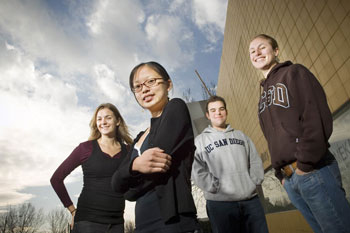UCSD Students Pursue E-Research Down Under in Calit2-Backed PRIME Program
By Melissa Marino, Monash University
Melbourne, Australia, August 2, 2006 -- Four students from the University of California, San Diego, have swapped their summer break for an Australian winter to participate in a highly sought-after e-research program at Monash University's Faculty of Information Technology in Melbourne.
|
The Pacific Rim Research Experiences for Undergraduates (PRIME) program at UCSD, with funding from the U.S. National Science Foundation and supplemental support from Calit2, has allowed the four students to take advantage of the opportunity to enhance and extend their studies using the Nimrod computing grid, developed at Monash.
Celia Croy, a biology major, said although the students could have pursued their studies at home, the trip to Australia had given them the chance to meet the grid's creators and enjoy a cultural experience at the same time.
"Our school wants us to be well-rounded individuals when we graduate," said Croy, who is using computational chemistry calculations to develop a more accurate tool for drug design.
Bioinformatics major Noah Ollikainen, who uses models such as the one Celia Croy is working on to test and identify potential drug candidates, said he wanted to travel abroad before he graduated. "This was the perfect opportunity to do that and do research at the same time," he said.
Angelina Altshuler, who along with fellow PRIME student Iwen Wu is using the software to help develop early computer simulations of the human heart, said they had come to Monash to learn about how the grid could be used for their projects.
"We're all doing projects in biological fields, and it's a new thing to be using the computer technology with biology," she said.
Program coordinator, Nimrod creator, e-research pioneer and Monash professor David Abramson said the program was a classic example of e-research at work, where supercomputer technology was applied to a specific area of research and research teams were linked throughout the world.
"It's bringing Information Communication Technologies [ICTs] together with whatever the research domain happens to be and doing things that you couldn't do before," he said. "Here we have biology and computer science being done globally -- that's e-research."
Abramson hopes the program, now in the third and final year of its pilot-project funding, will continue.
"It has already forged long-term international links and collaborations, and it's the students who underpin it," said Abramson. And the PRIME team in Melbourne echoed that sentiment.
The PRIME program at UCSD sent students on summer research experiences to three other Pacific Rim countries: China, Japan, and Taiwan. The program was developed and facilitated under the aegis of the UCSD-based Pacific Rim Applications and Grid Middleware Assembly (PRAGMA).
[This article first appeared on Monash Memo, the Australian university's news and information website, and is re-printed by permission.]
Related Links
Calit2 Helps UCSD Undergraduates 'PRIME' For The Future
Pacific Rim Applications and Grid Middleware Assembly (PRAGMA)
Pacific Rim International UniverSities (PRIUS)
Monash University
Related Articles
Calit2 Helps UCSD Undergraduates 'PRIME' For The Future


